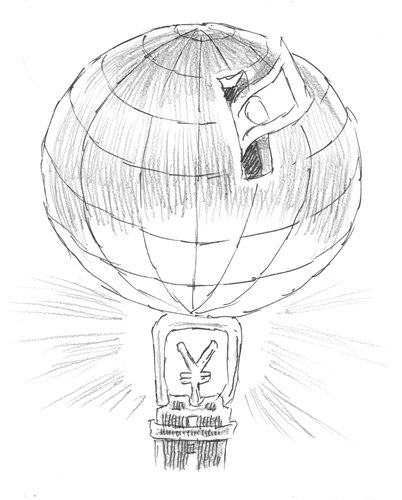COMMENTS / EXPERT ASSESSMENT
The B&R can usher in new global growth cycle

Illustration: Peter C. Espina/GT
From the perspective of the new structural economics, we can explain why China's "One Belt and One Road" (B&R) initiative can be widely welcomed, while other similar initiatives from the US have proved less popular. Primarily, along the B&R, there are more than 60 countries, with generally low per capita GDP. For these countries, economic revival is based on two prerequisites: First, the level of their industrial technology must be upgraded. Second, their infrastructure must be constantly improved to reduce transaction expenses. From the perspective of industrial upgrading, China is transferring its labor-intensive processing industry abroad, just like Japan in the 1960s and the Four Asian Tigers in the 1980s. This will offer new opportunities for GDP growth in these countries.
For other countries along the B&R route, they can also realize their industrialization and modernization with this opportunity. According to China's third industrial census, the number of people employed by the domestic manufacturing industry was 125 million, of which 85 million were working in labor-intensive industries. Developing countries with lower wage levels along the B&R route can follow a similar labor pattern and make a transition from an agricultural economy into a modern economy. If they can seize this opportunity, they will also achieve fast GDP growth of 8 to 10 percent per year for 20 to 30 years, just as China did amid its reform and opening-up.
Of course, to seize the opportunity, infrastructure must be improved to reduce transaction expenses. In terms of infrastructure construction, China is playing a complementary role with the countries along the B&R route in terms of technology, industrial development and capital, because China's yield of cement, electrolytic aluminum and flat glass accounts for more than half of the world's total output. In China, there is plenty of surplus industrial output, while it might be in short supply in other developing countries.
Owing to the rapid development of its construction ability in the past 30 years, China has cultivated a group of competitive construction forces. China's cost in building highways and high-speed railways is only one-third of that of some foreign companies. These favorable conditions could be offered to the countries along the B&R route to help build their infrastructure. Funding is also highly in demand when it comes to infrastructure construction. As the country with the world's largest foreign exchange reserves, China has enough money to support these countries.
The construction cycle and the payback time will both be very long, and this makes it harder for private capital to enter the field of infrastructure construction. Commercial banks are also reluctant to provide investment, as they tend to focus on short-term funding.
But in this case, infrastructure construction can be funded either by national coffers or state-guaranteed development financial organizations, such as the China Development Bank. Given that most developing countries are relatively poor, capital from overseas could remain the main source of infrastructure investment. Foreign funds can be managed in bilateral solutions. In addition, multilateral arrangements can also be adopted, such as the Asian Infrastructure Investment Bank.
However, the domestic, bilateral and multilateral funds are still not enough. In order to build this infrastructure, financial innovation is needed. Currently, there is about $3 trillion in sovereign funds and tens of trillions of US dollars in retirement funds all over the world. These sovereign funds or pension funds are generally used to buy long-term government bonds or invest in the stock market.
But after the global financial crisis in 2008, the interest from government bonds in developed countries is close to zero, while the stock market in developed countries is now unrealistically high and carries huge risks. In this situation, the financial innovation of putting sovereign funds or pension funds toward infrastructure construction is worthy of consideration.
Infrastructure is a bottleneck in each country's economic development, but it can be dealt with if new financial arrangements can be designed. The governmental, bilateral and multilateral funds can work together with other capital sources including sovereign and retirement funds to work the problem out as soon as possible.
The world economy still has not fully recovered from the global financial crisis, and the priority of the whole world is rapid development. China's B&R initiative coupled with financial innovation can help developing countries to enter a rapid development period and help the world out of the negative impact of the crisis. The B&R initiative coincides with historical trends, and that's why it can be supported by numerous countries.
The article was compiled based on a public speech by Justin Yifu Lin, former chief economist and senior vice president of the World Bank. bizopinion@globaltimes.com.cn
Read more in Special Coverage:

